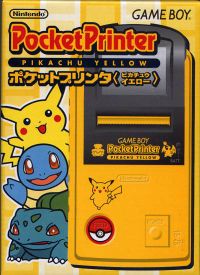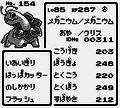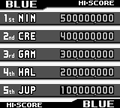Game Boy Printer

|
This article is incomplete. Please feel free to edit this article to add missing information and complete it. Reason: When did Nintendo released it in Europe and Australia? |
The Game Boy Printer (Japanese: ポケットプリンタ Pocket Printer) is a thermal printer designed for the Game Boy and Game Boy Color released on February 21, 1998 in Japan[1] and on June 1, 1998 in the United States[2] alongside the Game Boy Camera.
The printer is compatible with all Game Boy models except for the Game Boy micro and a Game Link cable is required to connect the printer to a Game Boy. It runs on six AA batteries.
When players of compatible games issue a print job, the output is printed on small rolls of thermal paper, with individual sheets being adhesive-backed and 1.5 in (3.8 cm) in diameter. The paper rolls were marketed as being able to take 180 pictures per roll but a typical roll would only be able to take 118 pictures at most (the dimensions of the paper and the margins between prints are calculated for each print job).
A special Pikachu Yellow Game Boy Printer was sold exclusively in Japan.
Printable features in Pokémon games
Core series
Players of Pokémon Yellow, Gold, Silver, and Crystal are able to print the following:
- Pokédex stickers
- Diplomas
- Pokémon Storage System Boxes
- Party Pokémon
- Pikachu's Beach hi-scoreY
- MailGSC
- Alph Ruins StampsGSC
The quality of prints is managed in the options. The games use three messages during the process: CHECKING LINK → TRANSMITTING → PRINTING.
Both the feature and its settings were removed in the Korean versions of Gold and Silver as the Game Boy Printer was not released in South Korea.
The background music played while printing is the same in all four games. It was later rearranged and used as the theme of the Pokéwalker screens in the main menu of Pokémon HeartGold and SoulSilver.
Pokédex stickers
Players may print physical copies of the Pokédex entries of individual Pokémon by using the PRNT option in the Pokédex. These prints are referred to as Pokédex stickers (Japanese: ずかんシール) in the Generation II games.
In Western versions, the dimensions of Pokédex stickers (160×192 px) exceed those of the Game Boy's screen resolution (160×144 px) because the print combines the two pages of the Pokédex entry. The stickers in the Japanese versions are not printed out with different dimensions because the Pokédex entries only use a single page. In the Japanese Generation II games, the printed font differs from the font used in-game.
- Mew Pokedex print Y.png
A print of Mew's Yellow Pokédex entry
- Mew Pokedex print Y JP.png
A print of Mew's Japanese Yellow Pokédex entry
- Mew Pokedex print C.png
A print of Mew's Crystal Pokédex entry
- Mew Pokedex print C JP.png
A print of Mew's Japanese Crystal Pokédex entry
Diploma
The diploma can also be printed as proof by the graphic artist at the Game Freak Development Room on the third floor of Celadon Condominiums. Printed diplomas have the dimensions 160×288 px.
Pokémon Storage System
The list of Pokémon in a given Box of the Pokémon Storage System can also be printed. Prints of Boxes display the full Box, including empty slots. Nicknames and levels are also listed alongside the Pokémon's species name. Like the Pokémon Storage System itself, the Western versions show a maximum of 20 entries for Pokémon, while the Japanese versions show 30 entries.
The dimensions of printed Boxes are 160×576 px in all versions.
Party Pokémon
In Pokémon Yellow, the chairman of the Pokémon Fan Club in Vermilion City can take a photo of one of the player's Pokémon in the Pokémon List and print it out. In the Generation II games, the Photo Studio in Cianwood City instead takes this role.
The dimensions in the Western Generation II games are 160×272 px.
Alph Ruins Stamps
In the Generation II games, players may generate so-called Alph Ruins Stamps of individual Unown using the PRINT function of the printer at the Ruins of Alph Research Center. The printer may only be used after the player has unlocked every entry of the new Pokédex's Unown Mode. Additionally, the Research Center's printer allows players to print empty stamps by choosing the VACANT option in the interface, which appears between Unown-Z and Unown-A.
Printed stamps have the dimensions 160×48 px.
An Alph Ruins Stamp of Unown-A
Spin-off games

|
This section is incomplete. Please feel free to edit this section to add missing information and complete it. Reason: Exact dimensions |

|
The picture used in this section is unsatisfactory. Please feel free to replace it so it conforms to Bulbapedia conventions. Reason: Use computer-generated screenshots instead. |
Pinball
Players may print out their high score tables in Pokémon Pinball.
Trading Card Game series
Pokémon Trading Card Game and Pokémon Card GB2: Here Comes Team GR! offer three different printing features to players. Players may print out copies of a single card, a list depicting one of their custom deck configurations, and/or a list of every card they own in the game.
A print of Charmander from Pokémon Card GB2
Game Boy Camera
The Game Boy Camera contains data for players to print out Pokémon stickers in addition to their photos. This is likely a nod to the fact that Game Freak programmed the Game Boy Camera software.
Printer errors
If there is an issue with the printer, the games return four types of errors and instruct the player to check the Game Boy Printer Manual. The following descriptions for each error are taken and adapted from the online support article provided by Nintendo of Europe.[3]
- Printer Error 1: The Game Boy Printer's batteries are empty.
- Printer Error 2: The Universal Game Link cable is not connected or is connected incorrectly.
- Printer Error 3: The printer's paper needs to be changed.
- Printer Error 4: The ambient temperature is inadequate (too high or too low). The printer must be used in a place with controlled temperature.
External links
- Game Boy Printer article on Wikipedia
References

|
This game-related article is part of Project Games, a Bulbapedia project that aims to write comprehensive articles on the Pokémon games. |











